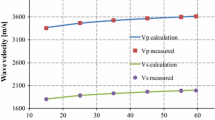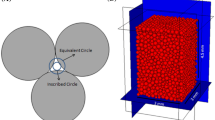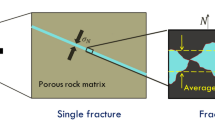Abstract
The effective stress coefficient is an essential geomechanical parameter required for estimation of the effective stress acting upon the subsurface reservoir porous rock formations and affecting their petrophysical properties. The values of the effective stress coefficient for various rock properties depend on the complex phenomena involving various types of rock deformation and alteration processes. This paper presents a discussion of the relevant factors and an effective method for accurate correlation of the Biot–Willis effective stress coefficient by means of a kinetics-based phenomenological model. This is accomplished by developing a modified power-law equation which describes the variation of the effective stress coefficient by various rock deformation and alteration processes at a macroscopic scale. This equation has five parameters which can be determined using the experimental data obtained by rock testing. The modified power-law equation is derived in a manner to satisfy the low- and high-end limit conditions of the effective stress coefficient exactly, which are the zero and unity values, respectively, for the Biot–Willis effective stress coefficient associated with the bulk volumetric strain. However, many empirical correlations presented in the literature cannot satisfy the low- and high-end limit values of the effective stress coefficient. The modified power-law equation is applied for correlation of the Biot–Willis effective stress coefficient associated with the bulk volumetric strain as functions of porosity, permeability, permeability/porosity ratio, and stress using the experimental data of various porous subsurface rock formations and artificial porous materials. The quality of the correlations is determined by means of the coefficient of regression or correlation and the root mean-square of the difference of the correlation values relative to the measured data. The correlation of the Biot–Willis coefficient with porosity yields the best results compared to the correlations obtained with permeability and permeability/porosity ratio. The stress dependence of the Biot–Willis effective stress coefficient of heterogeneous rock formations involving the slope change and hysteresis effects is correlated to describe the slope discontinuity caused by the deformation process transition and the hysteresis caused by the inertial and delay effects, fully elastic pre-damage, and/or irreversible rock damage during loading/unloading.













Similar content being viewed by others
Change history
30 July 2021
A Correction to this paper has been published: https://doi.org/10.1007/s11242-021-01656-5
Abbreviations
- A, B :
-
Empirical parameters
- B b :
-
Bulk modulus, Pa
- B s :
-
Solid grain modulus, Pa
- f :
-
Petrophysical rock property, dimension by the property
- RMS:
-
Root mean square relative deviation of correlation from measured values, dimensionless
- k :
-
Coefficient of proportionality
- K :
-
Intrinsic permeability of porous rock, m2
- \(K_{o} {\text{ and }}K_{\infty }\) :
-
Low- and high-end values of intrinsic permeability, m2
- n o and n ∞ :
-
Exponents of intensity, dimensionless
- p :
-
Pore fluid pressure, Pa
- R 2 :
-
Coefficient of regression or correlation
- \(x = z - z_{o} \,\) :
-
Transformed independent variable
- \(y = \frac{{\alpha_{o} - \alpha }}{{\alpha - \alpha_{\infty } }}\) :
-
Transformed dependent variable
- z :
-
Variable considered for correlation, dimension by the variable
- \(\alpha\) :
-
Biot–Willis poroelastic coefficient, dimensionless
- \(\alpha_{dn}\) :
-
Dynamic effective stress coefficient, dimensionless
- \(\alpha_{st}\) :
-
Static effective stress coefficient, dimensionless
- \(\sigma_{c}\) :
-
Confining stress, Pa
- \(\sigma_{cr}\) :
-
Critical stress at which a slope discontinuity occurs, Pa
- \(\sigma_{d}\) :
-
Differential stress, Pa
- \(\sigma_{e}\) :
-
Effective stress, Pa
- \(\sigma_{o} {\text{ and }}\sigma_{\infty }\) :
-
Low- and high-end values of effective stress, Pa
- ϕ :
-
Porosity of porous formation, fraction
- \(\phi_{o} {\text{ and }}\phi_{\infty }\) :
-
Low- and high-end values of porosity, fraction
- \(\varepsilon_{a}\) :
-
Axial strain
- o:
-
Low- end value
- ∞ :
-
High- end value
- – and + :
-
properties below and above critical shock condition
References
Alam, M.M., Fabricius, I.L., Christensen, H.F.: Static and dynamic effective stress coefficient of chalk. Geophysics 77, 2 (2012). https://doi.org/10.1190/GEO2010-0414.1
Al-Wardy, W., Zimmerman, R.W.: Effective stress law for the permeability of clay-rich sandstones. J. Geophys. Res. Solid. Earth. 109(B2), 229–245 (2004)
Berryman, J.G.: Exact effective-stress rules in rock mechanics. Phys. Rev. A 46(6), 3307–3311 (1992)
Berryman, J.G.: Effective stress for transport properties of inhomogeneous porous rock. J. Geophy. Res. 97, 17409–17424 (1992)
Biot, M.A.: General theory of three-dimensional consolidation. J. Appl. Phys. 12(2), 155–164 (1941). https://doi.org/10.1063/1.1712886
Biot, M.A., Willis, D.G.: The elastic coefficients of the theory of consolidation. J. Appl. Mech. 24, 594–601 (1957)
Boutéca, M., Sarda, J.P. and Laurent, J.: Rock Mechanics Contribution to the Determination of Fluid Flow Properties. SCA - Advances in Core Evaluation II - Reservoir appraisal. 2nd European Symposium of the Society of Core Analysts (Eurocas II), May 20-22, (1991), London. Gordon and Breach Science Publishers, Philadelphia
Brace, W.F.: Permeability of crystalline and argillaceous rocks. Int. j. Rock Mech. Min. Sci. 17(5), 241–251 (1980). https://doi.org/10.1016/0148-9062(80)90807-4
Brace, W.F.: Permeability of crystalline rocks: new in situ measurements. J. Geophy. Res.: Solid Earth 89, 4327–4330 (1984)
Byerlee, J.D., Zoback, M.D.: Permeability and effective stress: geologic notes. AAPG Bull. 59(1), 154–158 (1975)
Carmeliet, J. and Van Den Abeele, K.E.A.: Mesoscopic approach for modelling the nonlinear hysteretic response of damaged porous media in quasi-static and dynamic loading: Effects of pressure and. moisture saturation, Fracture Mechanics of Concrete Structures, de Borst et al. (eds), Swets & Zeitlinger, Lisse, pp. 11–18, ISBN 90 2651 825 O (2001).
Civan, F.: Scale Effect on Porosity and Permeability- Kinetics. Model, and Correlation, AIChE j. 47(2), 271–287 (2001)
Civan, F.: Relating Permeability to Pore Connectivity Using A Power-Law Flow Unit Equation. Petrophysics Journal 43(6), 457–476 (2002)
Civan, F.: Volume-averaging issues illustrated for porous-media thermo-fluid transport. Special Topics Rev. Porous Media Int. J. 5(1), 83–94 (2014)
Civan, F.: Effective-stress coefficients of porous rocks involving shocks and loading/unloading hysteresis. Soc. Petrol. Eng. SPE J. 26(01), 44–67 (2021). https://doi.org/10.2118/200501-PA
Cosenza, P., Ghoreychi, M., de Marsily, G., Vasseur, G., Violette, S.: Theoretical prediction of poroelastic properties of argillaceous rocks from in situ specific storage coefficient. Water Resources Res. 38(10), 251–2512 (2002). https://doi.org/10.1029/2001WR001201
Dassanayake, A.B.N., Fujii, Y., Fukuda, D., Kodama, J.-I.: A new approach to evaluate effective stress coefficient for strength in Kimachi sandstone. J. Petroleum Sci. Eng. 131, 70–79 (2015)
Detournay, E., Cheng, A.H.D.: Fundamentals of poroelasticity. In: Hudson, J.A. (ed.) Comprehensive Rock Engineering: Principles, Practice and Projects, pp. 113–171. Pergamon, Oxford (1993)
Fabre, D., Gustkiewicz, J.: Poroelastic Properties of Limestones and Sandstones under Hydrostatic Conditions. Int. j. Rock Mech. Min. Sci. 34, 127–134 (1997)
Fogler, H. S.: Elements of Chemical Reaction Engineering (5th Edition) (International Series in the Physical and Chemical Engineering Sciences), ISBN-13: 9780133887518, ISBN-10: 0133887510, Edition: 5, Publisher: Pearson, 992 p. (2016)
Gensterblum, Y., Ghanizadeh, A., Cuss, R.J., Amann-Hildenbrand, A., Krooss, B.M., Clarkson, C.R., Harrington, J.F., Zoback, M.D.: Gas transport and storage capacity in shale gas reservoirs–A review. Part a: Trans. Proces., J. Unconvent. Oil Gas Resources 12, 87–122 (2015)
Hampton, J.C. and Boitnott, G.N.: The misnomer of "Effective Stress" and its relation to Biot Coefficients, paper ARMA 18–1130 prepared for presentation at the 52nd US Rock Mechanics / Geomechanics Symposium held in Seattle, Washington, USA, 17–20 June (2018)
He, J., Rui, Z., and Ling, K.: A New Method to Determine Biot's Coefficients of Bakken Samples, Journal of Natural Gas Science and Engineering 35, Part A, 259–264 (2016).
Hofmann, R., Xiaoxia, X., Batzle, M., Prasad, M., Furre, A-K., and Pillitteri, A.: Effective pressure or what is the effect of pressure?, The Leading Edge, Dec., 1256–1260 (2005).
Hu, D., Zhou, H., Xie, S., et al.: Study of Biot’s coefficients of marble during plastic deformation phase. Rock Soil Mech. 30(12), 3727–3734 (2009). ((in Chinese))
Ingraham, M.D., Bauer, S.J., Issen, K.A., Dewers, T.A.: Evolution of permeability and Biot coefficient at high mean stresses in high porosity sandstone, International Journal of Rock Mechanics and Mining Sciences, Volume 96, pp. 1–10 (2017), ISSN 1365–1609, https://doi.org/https://doi.org/10.1016/j.ijrmms.2017.04.004.
Kümpel, H.-J.: Poroelasticity: parameters reviewed. Geophys. j. Int. 105(3), 783–799 (1991)
Kwon, O., Kronenberg, A.K., Gangi, A.F., Johnson, B.: Permeability of Wilcox Shale and Its effective pressure law. J. Geophys. Res. 106(B9), 19339–19353 (2001)
Li, Q., Aguilera, R., and Cinco-Ley, H.: A Correlation for Estimating the Biot Coefficient. Soc. Petroleum Eng. https://doi.org/10.2118/195359-PA (2019)
McCall, K. R., Boudjema, M., Santos, I. B., Guyer, R. A., & Boitnott, G. N.: Nonlinear, Hysteretic Rock Elasticity: Deriving Modulus Surfaces. American Rock Mechanics Association, paper ARMA-01–1171, The 38th U.S. Symposium on Rock Mechanics (USRMS), 7–10 July (2001), Washington, D.C
Merriam, D.F., Newell, K.D., Doveton, J.H., Magnuson, L.M., Lollar, B.S., Waggoner, W.M.: Northeast Kansas well tests oil. Gas Possibilities Precambrian Rocks, Oil Gas J. 105(35), 54–58 (2007)
Nermoen, A., Korsnes, RI, Christensen, H. F., Trads, N., Hiorth, A., Madland, M. V.: Measuring the Biot Stress Coefficient and its Implications on the Effective Stress Estimate, paper ARMA 13–282 presented at the 47th US Rock Mechanics/Geomechanics Symposium held in San Francisco, CA, USA, 23–26 June (2013).
Orlander, T., Adamopoulou, E., Jerver Asmussen, J., Marczyski, A.A., Milsch, H., Pasquinelli, L., Fabricius, I.L.: Thermal conductivity of sandstones from Biot’s coefficient. Geophysics 83(5), D173–D185 (2018). https://doi.org/10.1190/geo2017-0551.1
Qiao, L. P., Wong, R. C. K., Aguilera, R., and Kantzas, A.: Regression of Biot's Effective-Stress Coefficient for Permeability of Nikanassin Sandstone, Journal of Canadian Petroleum Technology, pp.193–197 (2012), Society of Petroleum Engineers. doi:https://doi.org/10.2118/150820-PA
Ramos da Silva, M., Schroeder, C., Verbrugge, J.-C.: Poroelastic behaviour of a watersaturated limestone. Int. J. Rock Mech. Min. Sci. 47(5), 797–807 (2010)
Salemi, H., Iglauer, S., Rezagholilou, A., Sarmadivaleh, M.: Laboratory measurement of Biot’s coefficient and pore pressure influence on poroelastic rock behaviour. The APPEA Journal 58, 182–189 (2018). https://doi.org/10.1071/AJ17069
Song, I., Renner, J.: Hydromechanical properties of Fontainebleau sandstone: experimental regression and micromechanical modeling. J. Geophys. Res. 113(B9), B09211 (2008)
Steeb, H., Renner, J.: Mechanics of poro-elastic media: a review with emphasis on foundational state variables. Transp. Porous Media 130, 437–461 (2019). https://doi.org/10.1007/s11242-019-01319-6
Terzaghi, K. Van.: Die Berechnung der Durchassigkeitsziffer des Tones aus dem Verlauf der hydrodynamischen Spannungserscheinungen. Sitzungsber. Akad. Wiss. Wien Math. Naturwiss. Kl. Abt. 2A, 132, 105 (1923).
Todd, T., Simmons, G.: Effect of pore pressure on the velocity of compressional waves in low-porosity rocks. J. Geophys. Res. 77(20), 3731–3743 (1972). https://doi.org/10.1029/JB077i020p03731
Tran, T., Binetruy, C., Comas-Cardona, S., Abriak, N.E.: Microporomechanical behavior of perfectly straight unidirectional fiber assembly: theoretical and experimental. Compos. Sci. Technol. 69(2), 199–206 (2009)
Walls, J. and Nur, A.: Pore Pressure and Confining Pressure Dependence of Permeability in Sandstone, Proceedings of the 7th Formation Evaluation Symposium, Canadian Well Logging Society, Calgary, 5–7 May (1979).
Xue, L., Qin, S., Sun, Q., Wang, Y., Lee, L.M., Li, W.: A study on crack damage stress thresholds of different rock types based on uniaxial compression tests. Rock Mech. Rock Eng. 47(4), 1183–1195 (2014)
Zhu, W., Montési, L.G. J., Wong, T‐F.: A Probabilistic Damage Model of Stress‐Induced Permeability Anisotropy during Cataclastic Flow.” Journal of Geophysical Research: Solid Earth, vol. 112, no. B10, p. n/a (2007)
Zimmerman, R.W.: Compressibility of Sandstones, Developments in Petroleum Science 29, Elsevier Science Publishers B.V., Amsterdam, 173p (1991)
Zoback, M.D., Byerlee, J.D.: The effect of microcrack dilatancy on the permeability of westerly granite. J. Geophys. Res. 80, 752–755 (1975)
Author information
Authors and Affiliations
Corresponding author
Additional information
Publisher's Note
Springer Nature remains neutral with regard to jurisdictional claims in published maps and institutional affiliations.
Appendix 1 Solution of the Ordinary Differential Equation
Appendix 1 Solution of the Ordinary Differential Equation
The ordinary differential equation described by Eq. (15) can be reformulated as:
Then, Eq. (22) can be expressed in a more convenient form as:
Consequently, an integration of Eq. (23) gives:
Application of the end-point limit condition given by Eq. (16) yields the integration constant C as:
Thus, substituting Eq. (25) into Eq. (24) yields an analytical solution as:
Note that this equation also satisfies the end-point limit condition stated by Eq. (17).
Rights and permissions
About this article
Cite this article
Civan, F. Parameterization of Biot–Willis Effective-Stress Coefficient for Deformation and Alteration of Porous Rocks. Transp Porous Med 138, 337–368 (2021). https://doi.org/10.1007/s11242-021-01611-4
Received:
Accepted:
Published:
Issue Date:
DOI: https://doi.org/10.1007/s11242-021-01611-4




